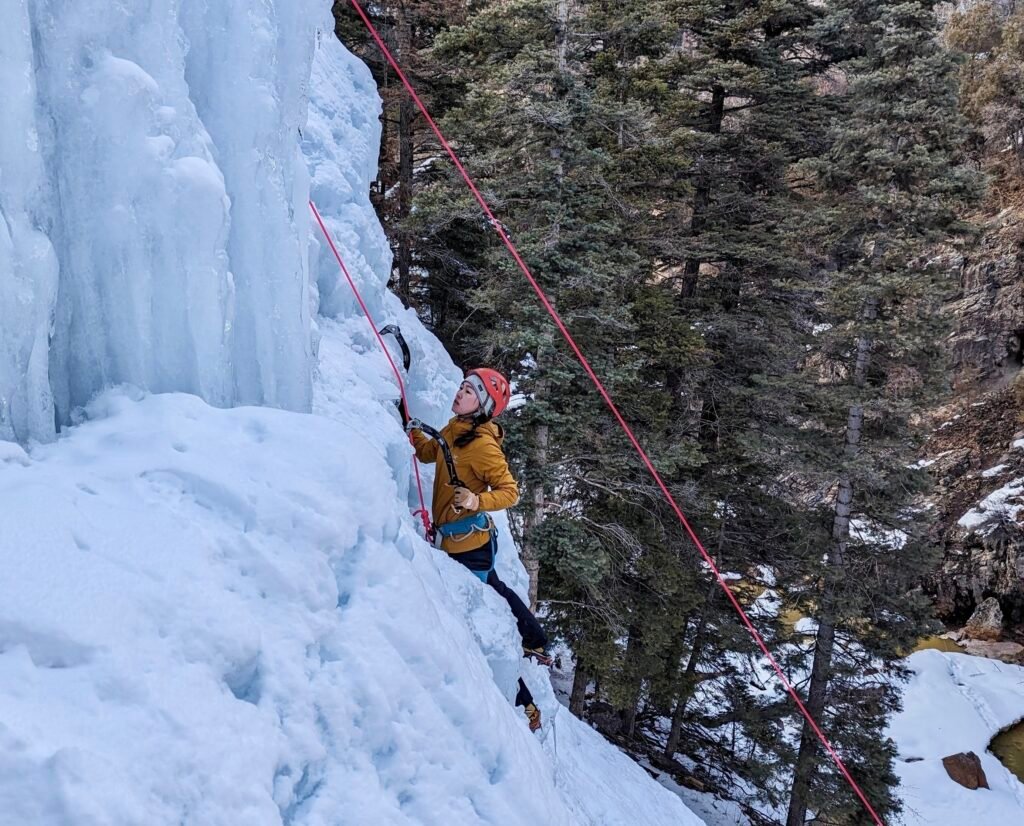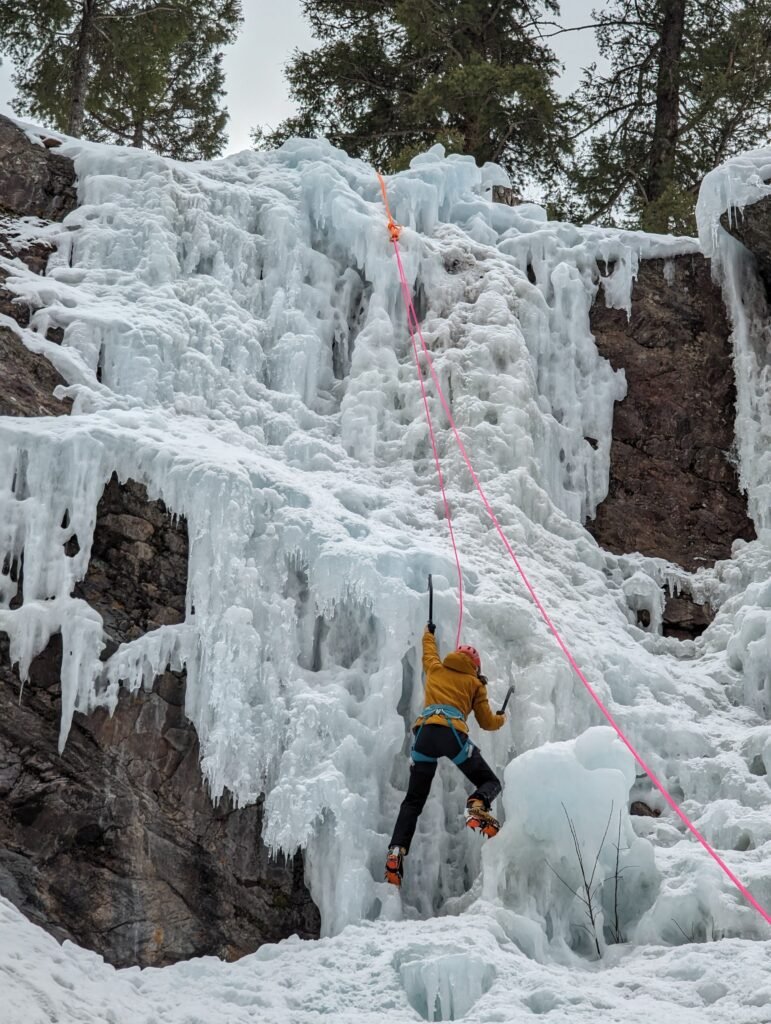The Arc’teryx Atom Hoody is a warm, highly-functional jacket and one of the best synthetic mid-layers on the market

Quick Pros and Cons
- fit and range of motion
- warmth and layering potential
- weather resistance
- helmet compatible hood
- expensive at $300
- variable quality control
- less packable than other options
The Arc’teryx Atom hoody is a versatile, lightweight synthetic mid-layer that has become a staple in the outdoor gear market. Known for its balance of warmth, functionality, and classic Arc’teryx good looks, it’s a popular choice among climbers, hikers, and general outdoor enthusiasts.
As part of Arc’teryx’s broader lineup of shells and insulation pieces like the popular Proton and beloved Beta, the Atom fills a unique niche by providing warmth and fairly good wind/weather resistance without the bulk, making it supremely suitable for layering under a shell or wearing as an outer layer in mild conditions. Its design, focused on high-performance insulation and minimalist aesthetics, caters to those seeking both function and style in a single jacket.
In this review, I’ll provide a detailed look at the Atom’s performance and features to help you decide if this classic Arc’teryx jacket (and its $300 price tag) is worth it for you.
How I've Tested and Used the Arc'teryx Atom
I’ve owned the 2024 Arc’teryx Atom for the last 9 months and used it in the contexts of backpacking, hiking, rock and ice climbing, and travel. I’ve worn it as a layering piece down to 13°F and as a standalone layer over a base layer or tee shirt in 60°F weather.
One real moment the jacket proved itself was during a short ice climbing half-day in on the Sólheimajökull glacier in Iceland, where there’s black volcanic soot everywhere. My Atom kept me warm as conditions got unexpectedly wet while I was lowered into and climbed out of glacial crevasses. In the process, it got absolutely splashed and covered with wet black volcanic soot and water droplets.
Yet, somehow, 4 hours later, the jacket still looked good as new and clean. A huge testament to the Atom’s weather resistance.
Design and Materials
The Arc’teryx Atom Hoody is insulated with Coreloft Compact, a proprietary synthetic fill that provides warmth and durability, supposedly even retaining heat when damp. The outer layer, Tyono 20 denier fabric, is lightweight, water-resistant, and durable, while the Polartec Power Stretch side panels allow for improved breathability and mobility, reducing potential for overheating.
This thoughtful construction makes the Atom ideal for higher-output outdoor activities, and it layers well under heavier jackets or functions alone in mild, to mildly wet conditions.
The fit reflects that dual purpose “stand alone” and “layering piece” ambition. It’s a bit fitted but allows for an impressive range of motion, which I’ll cover later.
Additionally, the hood is helmet-compatible, and I mean truly helmet compatible. Unlike some other jackets I’ve tested, notably the Himali Accelerator, this hood feels truly purpose-built to fit over a climbing or ski helmet.


Insulation, Breathability, and Warmth
The Arc’teryx Atom Hoody uses Coreloft Compact insulation, which offers warmth comparable to down (if a bit less warm), but with greater resilience against moisture. I would put the operating temperature range for this jacket as low as 40°F when worn alone.
For reference against a well-known product, on an October backpacking trip in Tahoe, I wore this layer over a Smartwool long sleeve while my friends rocked their Patagonia Down Sweaters.
In terms of breathability, the Atom Hoody stands out due to its Polartec side panels. These panels enhance airflow, allowing heat and moisture to escape during high-intensity activities like climbing or skiing. This feature sets it apart from fully insulated jackets, like the comparable synthetic Mountain Hardwear Compressor Hoody or Patagonia Nano Puff.
I have found the side panels provide just the right level of breathability in that the jacket still stays quite windproof.
Comfort and Mobility
It’s clear the Atom is designed with comfort and mobility in mind, catering to active users. The combo of fleece side panels and general trim fit allow for lots of upper body movement. The slim, low-profile fit of the Atom also minimizes bulk, allowing it to become a great layering piece under other jackets.
I also deeply appreciate the high rise on the collar when it’s zipped up, which helps keep your face warm in frigid environments.
Durability
The Arc’teryx has held up to being shoved in packs and has certainly been durable enough for ice climbing and backpacking purposes so far.
That said, I haven’t really felt a strong urge to test its rip and abrasion resistance because let’s be real, I did pay $300 for this jacket. That brings us to value and price.
Value, Price, and Deals on Arc'teryx
The price is the pitfall of this jacket, and I’ll admit it’s also the reason why this jacket sometimes stays home for me if I think I’ll be climbing on remotely sharp rock.
On that same Iceland glacier trek where the jacket proved it’s weather resistance, I had a discussion with my local guide on different outdoor brands. He had been working as a guide for over 10 years and told me whilst pointedly looking at my jacket, “I’ll try and buy all brands, except Arc’teryx. It’s too expensive. Because in the end, all jackets leak and all jackets rip the same.”
Take that how you will; a valuable perspective, though I’ve met other guides who swear by their Arc’teryx (a bit more palatable to purchase with pro deals, I’m sure).
With that in mind, if you’re looking to get Arc’teryx cheap or online, start looking in the shoulder seasons. Deals for Atom Hoody’s tend to pop up in late February/March and October when they change over the colorways and put past colors on sale. During that time, you can get an Atom for $240 to $210 depending on the color.
You can also purchase Arc’teryx at steep discounts from the Arc’teryx Outlet site. Sign up for their emails as they often do sitewide bigger cuts to prices.
Comparisons to Other Jackets
I often hear the Atom compared to the Patagonia Nano Puff ($289 for the hooded version), which frankly boggles my mind.
I have both jackets and have used both jackets. There is no doubt in my mind the Atom vastly outclasses the Nano Puff in terms of warmth, breathability, weather resistance, and fit.
I also tried and returned the similarly styled Mountain Hardwear Kor Airshell ($150 but widely available for <$80) as it felt, per its name, more air-y and breathable than what I wanted.
Comparable models people seem to like also include the Outdoor Research Ferrosi Hoody (approx. $90) and the Black Diamond First Light ($275). I have neither of these so can’t speak to them, but in my professional literature review of Reddit forums and own consumer research will just pass along that the Ferrosi seems to be a fan favorite as a budget alternative to the Atom.
Arc'teryx Atom vs. Proton
When purchasing the Atom, I also was contemplating the Atom Heavyweight ($350), Proton ($350), or Proton Heavyweight ($400). To add to the confusion, I was originally looking for the Atom LT, only to find out the Atom is the same as the former Atom LT. It has been renamed.
Aside from the $50 price difference, the key difference between Atom and Atom Heavyweight is that the Heavyweight does not have the Polartec fleece side panels, making the jacket a bit less breathable.
The key difference between the Arc’teryx Atom and Proton is breathability. The Proton is designed to be more breathable than the Atom.
For my purposes, I wanted more wind resistance so I chose the Atom.
Closing Thoughts
If you live in the NorCal like me, you’ll also see tech bros rocking this jacket, accessorizing with their $9 pour over coffees in hand. But make no mistake, though Arc’teryx is becoming increasingly popular in streetwear and as a lifestyle label, this Canadian brand truly makes no-nonsense mountain apparel that’s built to perform.
While it is a pricey purchase, it is also one of the best jackets I’ve tried and I will continue to use it until I wear it out.
